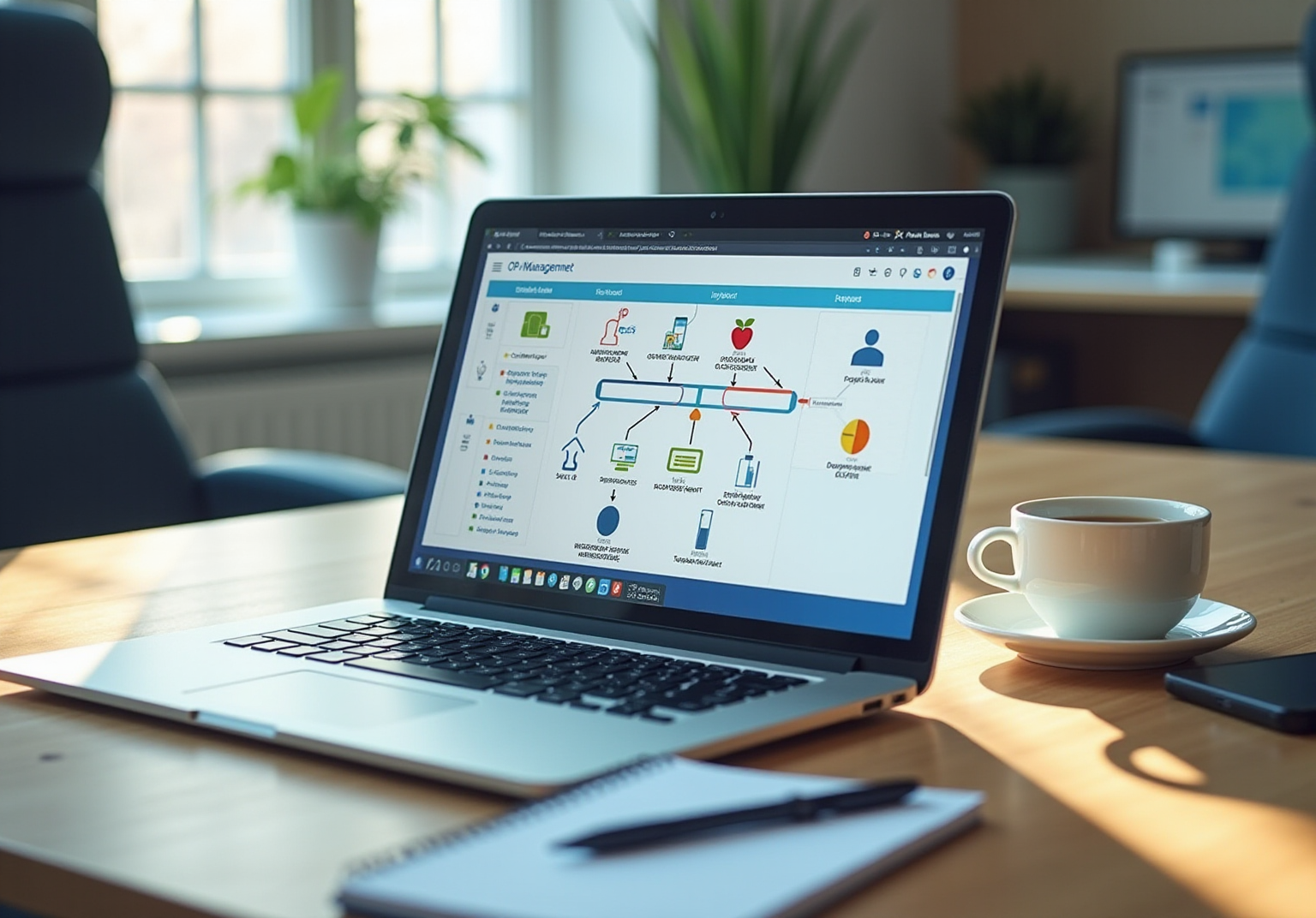
Overview
You might be wondering how to make your Standard Operating Procedures (SOPs) really shine. Well, this article lays out ten key steps that can help you structure them effectively. It’s all about clarity, getting everyone involved, and making sure you update your SOPs regularly. Why? Because these steps can seriously boost your operational efficiency!
Now, here’s the kicker: organizations that have well-defined SOPs tend to outperform their competitors by a significant margin. Plus, they can cut down on compliance-related risks. It just goes to show that when you take a structured approach, you’re not just improving performance—you’re also reducing errors. So, let’s dive into those steps and see how you can elevate your documentation game!
Key Highlights:
- SowFlow simplifies SOP creation and management, enabling quick and accurate documentation.
- Using SowFlow can improve operational efficiency by enhancing communication and reducing errors.
- Defining the scope of an SOP is crucial for relevance and compliance, leading to improved organisational performance.
- Organisations with clear SOPs can outperform competitors by 31% and reduce compliance-related risks by 60%.
- Engaging stakeholders in SOP development fosters ownership and enhances adherence to procedures.
- Choosing the right format for SOPs (e.g., step-by-step, flowcharts) improves clarity and training efficiency.
- Regular reviews and updates of SOPs are essential for maintaining relevance and operational efficiency.
- Measuring SOP effectiveness through usage metrics helps identify areas for improvement and training needs.
- Addressing challenges such as resistance to change and lack of training is key for successful SOP implementation.
Introduction
In a world where efficiency and compliance are super important, the way we structure Standard Operating Procedures (SOPs) is key to organizational success. You might be wondering how mastering the steps to effectively structure an SOP can actually help your business. Well, it can unlock streamlined processes that boost operational efficiency and create a culture of accountability. But here's the catch: many organizations hit common snags like unclear scopes and not enough stakeholder engagement. So, how can companies tackle these challenges and craft SOPs that really resonate with their teams?
Let’s dive into ten essential steps for structuring SOPs effectively. These steps will offer you valuable insights and practical strategies to elevate your documentation practices. Trust me, by the end of this article, you’ll be ready to take your SOPs to the next level!
SowFlow: Instant SOP Creation and Process Standardization
You might be wondering how to simplify the structure of an SOP for creating and managing Standard Operating Procedures. Well, SowFlow is here to help! This intuitive platform transforms the documentation process, allowing you to capture workflows instantly. With a handy Chrome extension, you can record everything right from your browser, making sure your procedures are documented quickly and accurately.
Imagine cutting down the time you spend on documentation while actually improving its quality. Sounds great, right? By using SowFlow, you can ensure that your team maintains consistency and compliance across all operations. Organizations that embrace these user-friendly documentation tools often see a boost in operational efficiency, thanks to streamlined communication and fewer errors.
Speaking of real-world success, look at companies like Southwest Airlines. They’ve implemented digital SOP management systems that give instant access to the latest procedures—essential for keeping safety and operational standards in check. Ann Vankrunkelsven, RA/QA Manager, puts it perfectly: 'Standard Operating Procedures are essential tools for ensuring compliance, maintaining quality, and promoting safety in medical device companies.'
So, how can SowFlow help your company? By developing efficient SOPs, you’ll create a solid foundation for training new staff and standardizing the structure of an SOP. This leads to a more organized and scalable operation, making your life a whole lot easier!
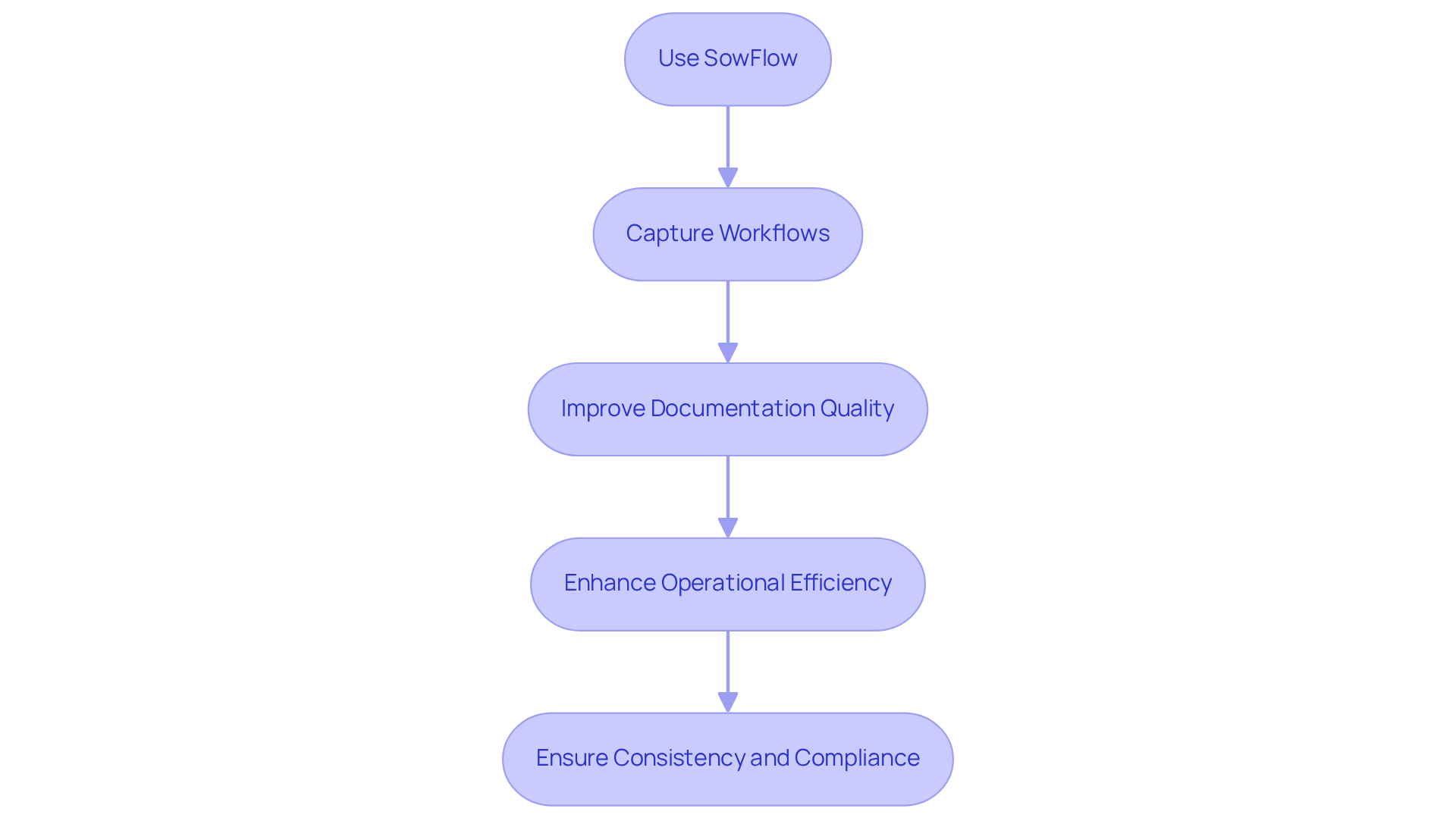
Define the Scope: Establishing Boundaries for Your SOP
Defining the scope of your SOP is super important for keeping things clear and effective. You might be wondering what that really means. Well, it’s all about outlining which tasks the SOP will cover and who it’s meant for. By setting these boundaries, you not only stay focused but also boost relevance, which is key for getting users on board and ensuring compliance.
Did you know that organizations with clearly defined standard operating procedures outperform their competitors by a whopping 31%? That really shows how crucial it is to nail down the scope. Plus, effective SOPs can cut compliance-related risks by up to 60%. That’s a big deal! Operations managers often point out that having clear limits in standard procedures helps prevent confusion and enhances workflows, leading to better compliance among team members.
For example, companies that have successfully defined their SOP scopes often see significant improvements in operational efficiency and employee engagement. So, how can you define SOP boundaries effectively? Engaging stakeholders during the development phase is a great start. It’s also important to regularly review and revise the SOP to keep it current, and using visual aids can really help with understanding.
By focusing on these elements, you can create SOPs that not only guide employees effectively but also foster a culture of accountability and operational excellence. Now, let’s dive into how you can make this process work for you!
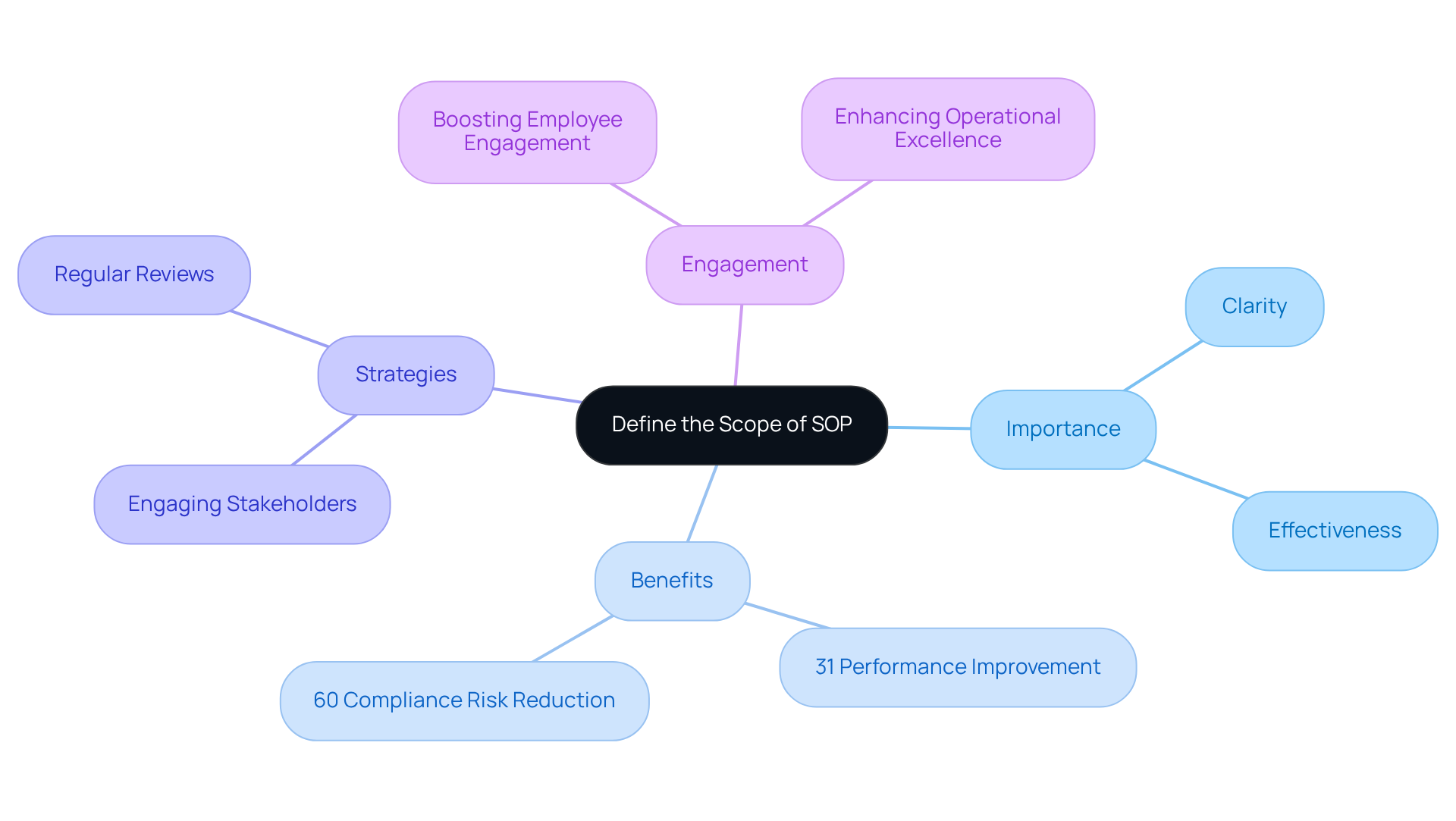
Gather Information: Collecting Essential Details for SOP Development
Collecting information for your SOP is a crucial step, and it’s all about getting everyone involved! You might be wondering how to start. Well, engaging with stakeholders, checking out existing documentation, and observing activities in action can really make a difference. This way, your SOP will truly reflect what’s happening on the ground and include insights from those who will actually use it. Plus, when you involve your team during this phase, it creates a sense of ownership, which is a game-changer for compliance.
Research shows that when you gather information collaboratively, you end up with a more effective structure of an SOP. It’s all about encouraging transparency and building trust among stakeholders. Organizations that bring stakeholders into the mix early on often see better solutions and higher acceptance rates for new procedures. Speaking of that, have you tried using SowFlow's instant documentation solution? It simplifies the whole process, making sure all the important information is easily accessible and up-to-date.
With SowFlow, updating and revising documentation is a breeze, which is super handy in the SOP development process. By prioritizing stakeholder consultation—think meetings and workshops—you can develop the structure of an SOP that truly resonates with users. This ultimately drives better adherence and boosts operational efficiency. So, why not dive in and explore how these strategies can work for you?
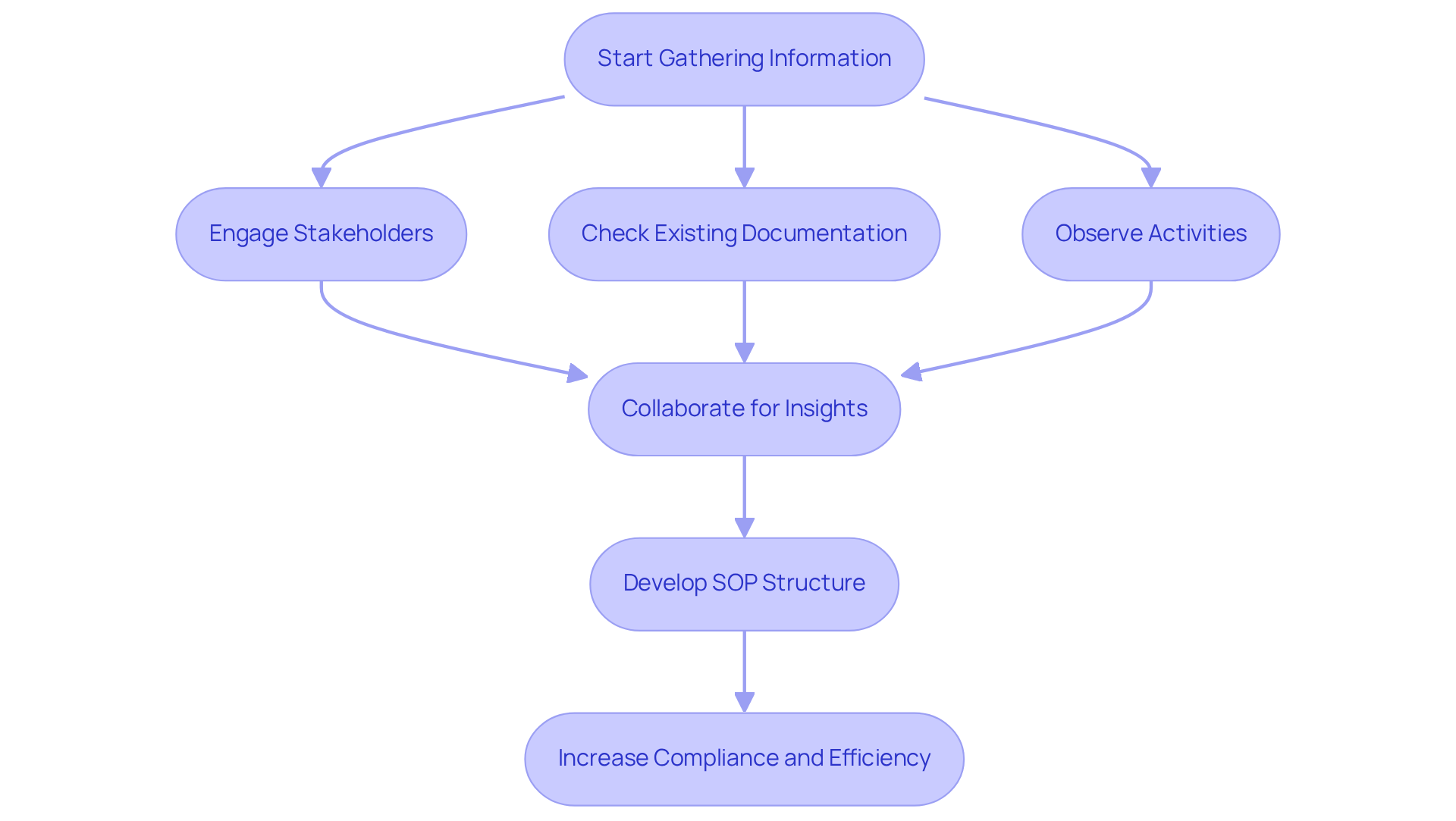
Choose the Format: Selecting the Best Structure for Your SOP
Choosing the right structure of an SOP is crucial for ensuring that everything is clear and easy to use. You might be wondering what formats are out there, right? Well, common options include:
- Step-by-step instructions
- Flowcharts
- Hierarchical structures
The best format really depends on the complexity of the procedure and the audience's preferences concerning the structure of an SOP. For example, if you're dealing with a straightforward task, step-by-step instructions work wonders. But if the workflow is a bit more complicated, flowcharts can really help illustrate the process. And if there are multiple sub-steps or categories, a hierarchical framework might just be the way to go.
Now, let’s talk about why a well-structured SOP matters. Training pros often point out that having a clear SOP not only makes things easier to understand but also speeds up training for new employees. Did you know that organizations with clear and concise SOPs see a noticeable drop in onboarding time and a boost in employee confidence? Take a manufacturing company, for instance; they switched to a flowchart format for their SOPs and experienced a whopping 30% decrease in training time, helping new hires get up to speed faster.
It's interesting to note that the effectiveness of different structures of an SOP can really depend on the context. Organizations that customize their SOP formats to fit their teams' specific needs often notice better adherence to procedures and fewer mistakes. Ultimately, choosing the right structure of an SOP is not just about aesthetics; it’s about creating a space where employees can easily find and understand the information they need to perform their jobs efficiently.

Involve Stakeholders: Engaging Users in SOP Development
Engaging stakeholders in the structure of an SOP development process is essential for creating documents that are both practical and user-friendly. You might be wondering how to make that happen. Well, effective workshops, interviews, and surveys can help gather valuable feedback from those who will actually implement the SOP. Organizations that actively involve participants in crafting SOPs have reported a 30% decrease in deviations and a 40% increase in reproducibility. That’s some serious evidence of the benefits of getting everyone on board!
Now, let’s think about why incorporating feedback is so important. Not only does it help tackle potential issues early, but it also ensures that the SOP truly aligns with the needs and expectations of its audience. This alignment is key! Did you know that 73% of consumers consider customer experience an important factor in their purchasing decisions? This principle applies to internal processes too. Operations managers have seen that when participants are engaged in creating SOPs, compliance rates soar, and implementation goes much smoother.
So, how can you effectively involve participants in SOP development? Consider organizing workshops that encourage open dialogue and collaboration. This approach fosters a sense of responsibility among participants, enhancing their compliance with procedures. By prioritizing participant involvement, organizations can create the structure of an SOP that boosts operational efficiency and promotes continuous improvement and satisfaction among team members. Sounds like a win-win, right?

Publish the SOP: Ensuring Accessibility for All Users
Once the SOP is finalized, you might be wondering how to make it easily accessible for everyone. Well, publishing it in a centralized document management system is a great start! This not only streamlines access but also cuts down on confusion, making document distribution so much more effective. Did you know that organizations focusing on accessibility can tap into a whopping $13 trillion market? That really highlights the financial impact of overlooking accessibility.
Now, clear communication about where to find the SOP is key to promoting its use. Documentation specialists often emphasize that using digital tools for distribution can boost accessibility and create a culture of compliance and efficiency within your organization. Speaking of tools, let’s talk about SowFlow. Anastasia Masadi, a Product Owner, shares, "SowFlow has been a game changer in the way we document work and deliver to our clients. I do not have to take each screenshot separately, and do not even have to leave the browser while I am creating SOPs and training materials. SowFlow gave me time from my life back."
By prioritizing accessibility in SOP distribution and leveraging tools like SowFlow, you can ensure that all team members, no matter their abilities, benefit from the information provided. So, why not explore these options and see how they can work for you?

Promote the SOP: Encouraging Adoption and Compliance
You might be wondering how to promote the SOP effectively. Well, it’s all about sharing its benefits and importance within your organization. Think about using:
- Training sessions
- Newsletters
- Team meetings
to get the word out. By emphasizing how the SOP can simplify workflows and boost efficiency, you can really encourage everyone to embrace it.
Now, let’s dive into how SowFlow can help. With its instant documentation solution, your teams can create guides effortlessly and keep them updated. This way, the SOP stays relevant, even in our fast-changing business world. Plus, ongoing support and resources through SowFlow can reinforce the SOP's importance and encourage compliance. Ultimately, this enhances team efficiency and promotes knowledge sharing—who doesn't want that?

Review and Amend: Keeping Your SOPs Up-to-Date
You might be wondering how to ensure the effectiveness of the structure of an SOP over time. Well, it’s all about having a systematic review method in place that regularly checks their relevance and accuracy. This means gathering feedback from the folks who actually use them and keeping an eye on any changes in processes or regulations that might need updates. Did you know that research shows organizations that keep their SOPs current see a 30% reduction in data discrepancies and a 25% decrease in query resolution time? That's a pretty big win for operational efficiency!
Now, let’s dive into how creating a culture of ongoing improvement can really make a difference. Organizing feedback sessions can significantly enhance the accuracy and relevance of your SOPs. For example, a biotech firm found that by actively involving their frontline staff in the review process, they saw a remarkable boost in compliance and overall operational efficiency. Operations managers often say, 'Keeping SOPs current isn’t just about compliance; it’s about making sure our teams can work effectively and efficiently.' By prioritizing regular reviews and updates, you can ensure that the structure of an SOP continues to serve its purpose, ultimately supporting better operational efficiency while staying in line with any regulatory changes.
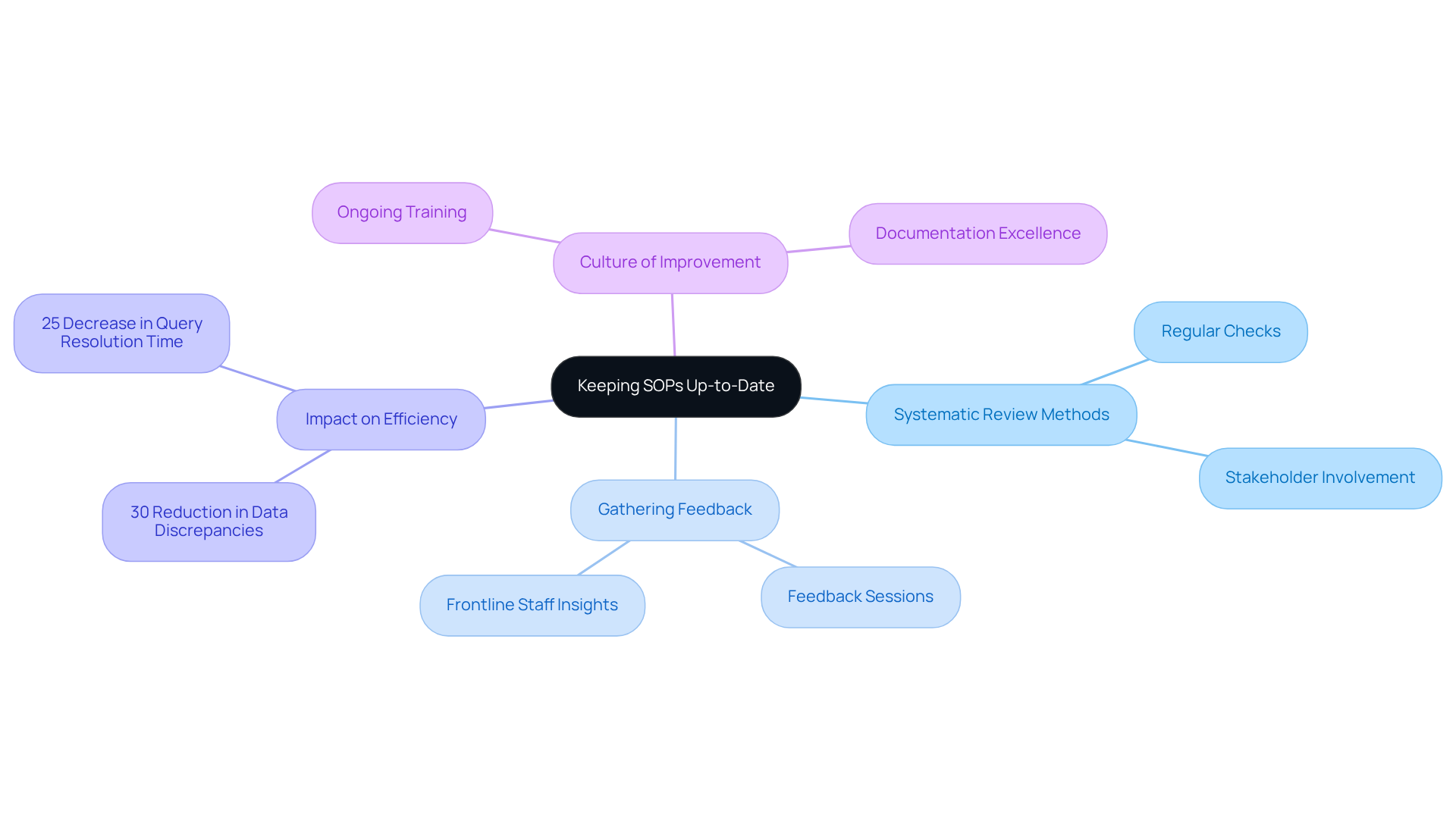
Analyze Usage Metrics: Measuring SOP Effectiveness
You might be wondering how to truly evaluate the effectiveness of the structure of an SOP, right? Well, it all starts with taking a good look at usage metrics—think compliance rates, user feedback, and training outcomes. Research shows that organizations that adopt these procedures often see some pretty significant improvements in compliance. Many even report a boost in operational efficiency! For instance, once standard operating procedures are in place, adherence rates can soar, leading to fewer mistakes and a nice bump in productivity.
Now, let’s talk tools. Have you heard of GoAudits? It’s a fantastic resource that helps companies create, update, and track their digital standard operating procedure checklists. Plus, it comes with surveys and analytics software that are crucial for gathering insights on how well these procedures are being followed and their overall impact on operations. These metrics don’t just help you make necessary revisions; they also pinpoint specific training needs. This way, your standard operating procedures can keep serving as effective resources within your organization.
As industry specialists often say, using metrics to assess the effectiveness of the structure of an SOP is essential for enhancing your business operations. By tapping into these insights, you can really foster a culture of continuous improvement and accountability in your organization. So, why not start exploring these options today?
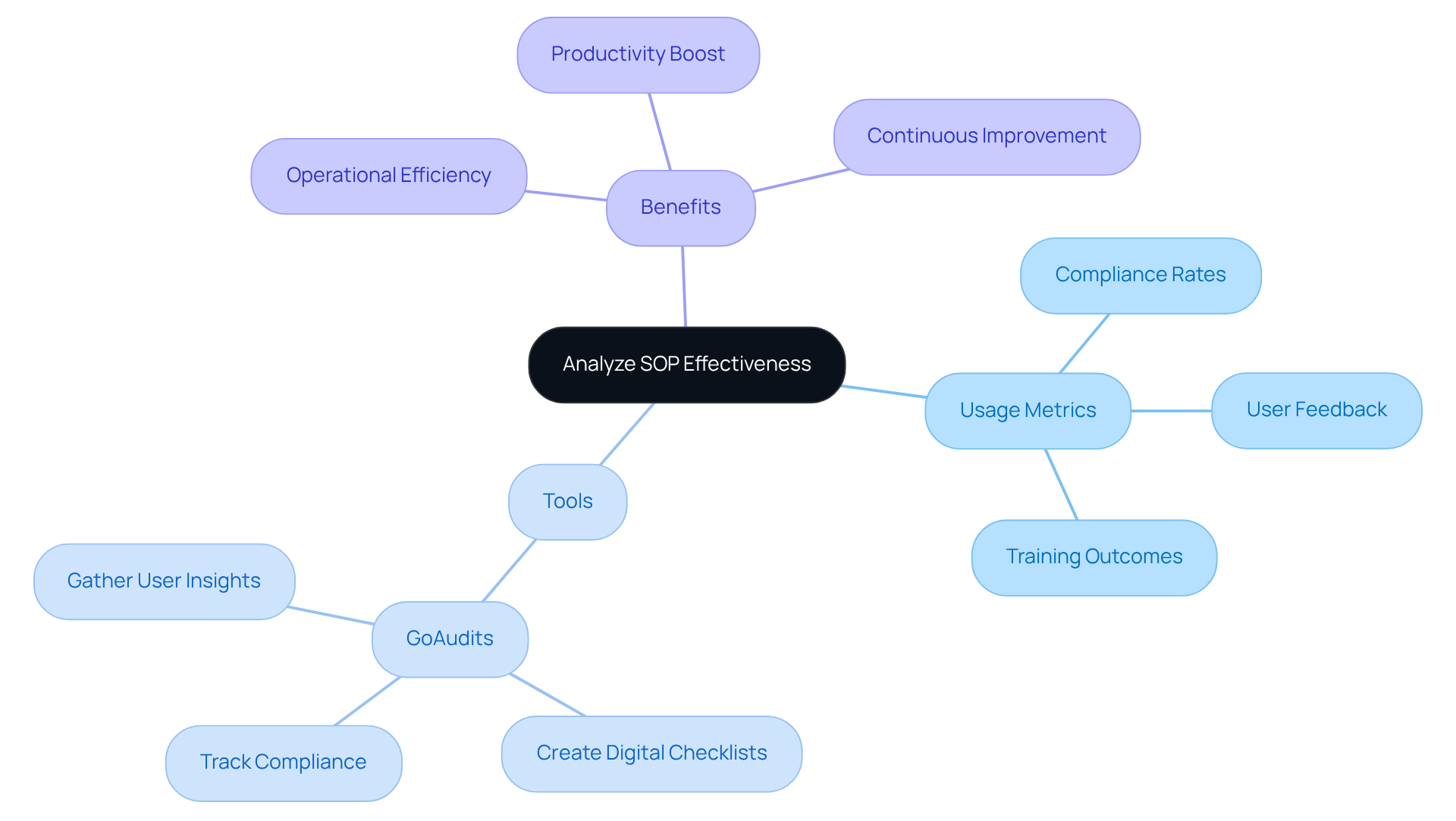
Address Challenges: Overcoming Barriers to SOP Adoption
You might be wondering why organizations often struggle with the structure of an SOP when it comes to implementing Standard Operating Procedures. Well, resistance to change, lack of awareness, and inadequate training are pretty common hurdles. To tackle these challenges, fostering a culture of open communication is key. Organizations should really focus on comprehensive training programs that not only lay out the procedural details but also emphasize the benefits of the structure of an SOP. This approach can significantly enhance employee buy-in.
For instance, studies show that organizations that roll out robust training initiatives often see a drop in resistance. Employees feel more equipped and informed, which makes a world of difference. Take, for example, a large-scale clinical trial that utilized the structure of an SOP; this implementation led to a 30% reduction in data discrepancies and a 25% decrease in query resolution time. Pretty impressive, right?
Now, let’s talk about another critical strategy: soliciting feedback from users. Actively engaging employees in the structure of an SOP during the development process helps organizations pinpoint specific concerns and areas for improvement. This cooperative method not only boosts adherence but also leads to more efficient procedures that align with the structure of an sop. Successful cases reveal that organizations that encourage user feedback often enjoy increased adoption rates and enhanced operational efficiency. Just look at that biotech company that saw a 50% decrease in inspection observations after standardizing their Clinical Research procedures.
Speaking of keeping things relevant, implementing a version control system and setting up automated reminders for scheduled reviews can help ensure that SOPs stay up-to-date. This goes a long way in reducing resistance. Change management professionals emphasize that clear communication and ongoing support are essential for navigating the complexities of the structure of an SOP during implementation. Ultimately, this fosters a more adaptable and resilient organizational culture.

Conclusion
Implementing an effective structure for Standard Operating Procedures (SOPs) is crucial for any organization looking to boost operational efficiency and compliance. You might be wondering how to make this happen, right? Well, by leveraging tools like SowFlow, companies can streamline their documentation processes. This ensures that SOPs are not just well-structured but also easily accessible and regularly updated. This approach fosters a culture of accountability and continuous improvement—essential for maintaining high standards across all operations.
Throughout the article, we’ve highlighted key steps for structuring an SOP. These include:
- Defining the scope
- Gathering information
- Choosing the right format
- Involving stakeholders
Each of these elements is significant in creating SOPs that resonate with users and promote adherence. By actively engaging employees in the development process and making procedures accessible, organizations can significantly reduce compliance-related risks and enhance overall performance.
Now, let’s talk about the effectiveness of SOPs. It really hinges on ongoing evaluation and adaptation. Organizations need to embrace a systematic review process, analyze usage metrics, and tackle common challenges to cultivate a culture that values standardization. By prioritizing these practices, businesses can not only enhance their operational workflows but also empower their teams to work more efficiently and confidently. Embracing these strategies will pave the way for a more robust and agile organizational framework, setting the stage for success in today’s dynamic environment.
Frequently Asked Questions
What is SowFlow and how does it assist with SOP creation?
SowFlow is an intuitive platform designed to simplify the creation and management of Standard Operating Procedures (SOPs). It allows users to capture workflows instantly and includes a Chrome extension for easy documentation directly from the browser.
What are the benefits of using SowFlow for SOP documentation?
By using SowFlow, organizations can reduce the time spent on documentation while improving its quality. It helps maintain consistency and compliance across operations, leading to increased operational efficiency and fewer errors.
Can you provide an example of a company that successfully uses digital SOP management?
Southwest Airlines is an example of a company that has implemented digital SOP management systems, providing instant access to the latest procedures, which is essential for maintaining safety and operational standards.
Why is defining the scope of an SOP important?
Defining the scope of an SOP is crucial for clarity and effectiveness. It outlines the tasks the SOP will cover and the intended audience, helping to stay focused and relevant, which boosts user compliance and understanding.
How do clearly defined SOPs impact organizational performance?
Organizations with clearly defined SOPs outperform their competitors by 31% and can reduce compliance-related risks by up to 60%. Clear limits in procedures help prevent confusion and enhance workflows.
What strategies can be used to define the boundaries of an SOP effectively?
Engaging stakeholders during the development phase, regularly reviewing and revising the SOP, and using visual aids can help effectively define SOP boundaries.
What is the importance of gathering information for SOP development?
Collecting information is essential for developing an effective SOP. Engaging stakeholders, reviewing existing documentation, and observing activities ensure the SOP reflects real practices and fosters a sense of ownership among users.
How does stakeholder involvement affect SOP effectiveness?
Involving stakeholders early in the process leads to better solutions and higher acceptance rates for new procedures. Collaborative information gathering encourages transparency and builds trust, enhancing compliance.
How does SowFlow facilitate the updating and revising of SOP documentation?
SowFlow simplifies the process of updating and revising documentation, ensuring that important information remains easily accessible and current throughout the SOP development process.
👍
What others are liking
5 Steps to outline your ideal documentation structure
5 MINS READ
Where to start the your journey of mapping out your ideal documentation structure, aligning it with the very heartbeat of your organization?
Defining a winning level of detail in your process
3 MINS READ
What is too much detail, and what is too little? This article described in that winning level detail about what detail is enough.





